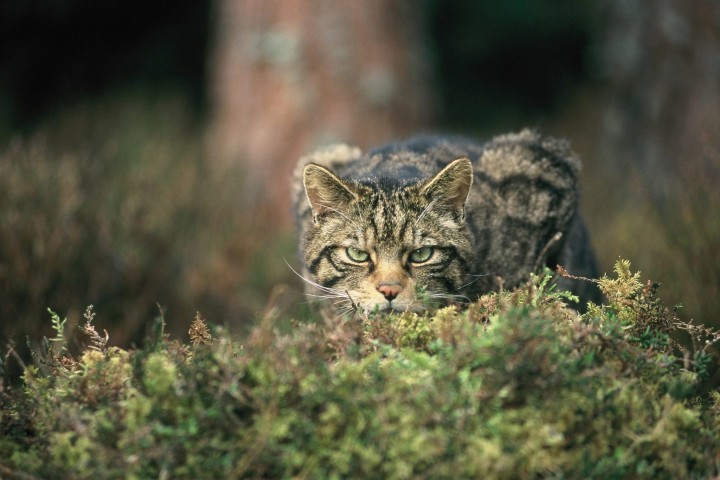Scotland Considers Continental Wildcats to Save Native Species from Extinction

Conservationists could release wildcats captured from other European countries in the Scottish Highlands in a final effort to protect Scotland’s population from extinction.
Recent genetic testing by the Royal Zoological Society of Scotland of 276 Scottish wildcat samples found those in the wild are so heavily interbred with domestic cats that they are close to becoming functionally extinct.
Leading ecologists have said the trend could be reversed by capturing pure-bred wildcats on the continent and releasing them in isolated and unspoilt parts of the Highlands, hoping they can replenish the Scottish population with pure wildcat DNA.
The proposal was discussed in September at a meeting of conservation agencies and wildlife experts involved in Scottish Wildcat Action, the government-funded umbrella organisation charged with protecting the species.
Sir John Lister-Kaye, a naturalist involved in the SWA, said the core proposal being developed was to set up a new captive breeding and release programme using wild caught animals and captive Scottish wildcats, which are generally purer genetically.
SWA is drafting proposals to house them in a new wildcat breeding centre in the Highlands, probably based at the Highland wildlife park near Aviemore, a safari park which includes a captive wildcat enclosure owned by the RZSS.
The park is already home to the UK’s only breeding polar bear, a Siberian tiger enclosure and a Eurasian wolf enclosure. There are 94 captive wildcats held in various zoos and private collections around the UK.
“Everyone agreed that captive breeding was the way forward,” Lister-Kaye said. “If there are insufficient high quality wildcats the SWA would introduce pure wildcats from other parts of Europe, and that is now seen to be the way forward to save the species.”
The scheme would require approval, funding and licensing by Scottish Natural Heritage, the government agency charged with protecting native wildlife, and Scottish ministers.
A similar translocation strategy was used in 2009 in a government-funded project by the RZSS and Scottish Wildlife Trust to release beavers in Argyll in south-west Scotland, using animals trapped in Norway. Eventually captive animals from elsewhere in Scotland were added, because some of the Norwegian beavers were unable to adapt or died in quarantine.
The RZSS genetic study, which was published last week in the Journal of Evolutionary Applications, tested samples from 276 live wild and captive wildcats, and samples from dead specimens including roadkill, and compared them with 19 domestic cat samples.
Dr Helen Senn, who led the study, said the bulk of the wildcats shared the same gene pool as their domestic counterparts: “Having tested almost 300 wild-living and captive wildcats, we now have genetic data which confirms our belief that the vast majority of Scottish wildcats living in the wild are hybrids to one extent or another.”
Lister-Kaye said the RZSS research confirmed a long-standing belief that domestic cat genes were dominant in non-captive Scottish wildcats across the country, a trend being reinforced by continued interbreeding. The point was now being reached where wildcats, which are naturally shy and elusive, would disappear from the Highlands.
Wildcats are found in areas of France, Spain, the Balkans, the Caucasian steppes, the Indian subcontinent and Africa, but they are so rare the International Union for the Conservation of Nature (IUCN) has placed them on the red list of endangered species.
The Scottish population, which was split off from the continental population about 9,000 years ago, after the last ice age, is in crisis. The IUCN says its status is bad and declining. Dr Roo Campbell, SWA’s priority areas manager, said only 100 to 300 survive in the wild in Scotland and were reduced to living in shrinking pockets of the Highlands.
Campbell said the SWA was waiting for the results of a special review by the IUCN of Scotland’s situation before finally deciding on a rescue strategy. “The very high levels of hybridisation reported in [Senn’s] paper is a very specific and challenging situation we are facing in Scotland,” he said.
Lister-Kaye said the wildcats’ natural habitats had shrunk dramatically because farming and commercial forestry plantations had severely reduced their range, cutting off their food supplies. That drives them closer to farms and villages, where they are more likely to crossbreed with domestic and feral cats.
“I’m optimistic,” he said. “I don’t actually think it’s terribly complicated. It takes money and time. Where I think we’ve got a real problem is in reinstating habitat. Where it exists it is very, very patchy.”
